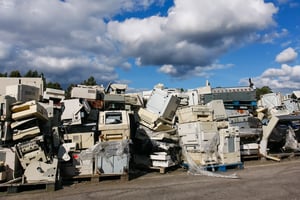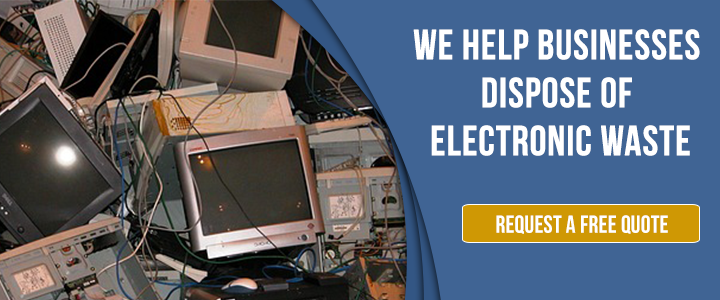Knowing how to properly dispose of your company’s electronic waste is critical to keeping the staggering amount of e-waste tossed each year down.
Each year in the United States, more than 9 million tons of electronic equipment are disposed of into landfills. Globally, that number is closer to 50 million tons.
Perhaps more concerning, although electronic waste represents 2% of trash in U.S. landfills, it accounts for about 70% of toxic waste.
What is electronic waste? E-waste includes a variety of everyday products, from televisions to cell phones, printers, lamps and computer equipment. In the industrial sector, it includes circuit boards to power supply units, lab equipment, tablets and servers.
While adding any type of waste stream to a landfill can be problematic due to environmental concerns, e-waste can be especially harmful since several components of electrical equipment are considered hazardous. Because of this, federal and state laws require the appropriate disposal of this equipment.
California is home to certified companies that will recover unwanted electronics and safely dispose of your e-waste. Here are the most effective and safe electronic waste disposal methods to consider for your business.
Drop Off At Designated Facilities
 For companies that have a small amount of electronic waste to dispose of, dropping off that waste at a designated facility may be the most practical choice.
For companies that have a small amount of electronic waste to dispose of, dropping off that waste at a designated facility may be the most practical choice.
CalRecycle offers a directory on its website that includes companies and organizations that participate in the Covered Electronic Waste Recovery and Recycling Program.
This site allows users to search by county or city, as well as by entering your address to locate drop off sites near you. When the results are revealed, you can view individual facility’s contact information by clicking on the name of the company.
If you choose this route for your electronic waste disposal, it is important to keep a few things in mind.
Check with the facility prior to dropping off your e-waste to determine which items are accepted, as well as hours and potential charges. Although some sites may offer electronic recycling, they may not recycle all electronic products.
For example, while one site may accept computer towers, it may not accept printer cartridges or larger appliances found in your office space.
Check with the facility about drop-off quantity limits as well. Some facilities may only accept a certain number of electronic pieces at once. Even if there are no limits for drop-off, you may be limited by how much e-waste you can transport to the facility in one trip.
Finally, before dropping off e-waste, make sure you remove any sensitive data. Deleting files does not mean the data has been removed. Software professionals can help you clean off a drive so that you do not expose yourself and company to data thieves.
Enlist The Help Of A Waste Disposal Company
While leaving your e-waste at a drop-off facility may seem like the most practical option, if your company regularly produces e-waste or has a large amount of e-waste to dispose of, a waste disposal company may be the better choice.
For example, if you are installing new computers in every office of your facility or have larger items that make a trip to the facility more difficult, a waste disposal company can help you dispose of this e-waste safely … while creating less of a headache for you.
 One important note to consider is that a waste disposal company certified in safe e-waste removal may be able to accept items that some drop-off facilities cannot. These include spent batteries or mercury-containing thermostats.
One important note to consider is that a waste disposal company certified in safe e-waste removal may be able to accept items that some drop-off facilities cannot. These include spent batteries or mercury-containing thermostats.
It can also be difficult for a company to distinguish what is considered e-waste and what is not. While it may seem obvious what is considered an electronic, a large number of substances found in electronic devices are not considered hazardous.
Consider this example:
Zinc plating is often found in steel production parts. Zinc in itself is not considered to be harmful. Aluminum, which is another valuable metal that is found in most electronics goods, is considered to be generally safe as well. However, when these items are paired with raw materials that DO pose a contamination risk, such as beryllium oxide found in computer towers, the entire piece of equipment is considered to be a risk.
What do you do? You should never attempt to separate toxic items from their non-toxic counterparts. This should only be done by a professional.
A certified electronic waste disposal company can help you determine the next step, including what can be disposed of safely on your own versus what requires hazardous waste disposal by law.
This is important, since improper disposal can lead to costly fines, a damaged reputation and environmental hazards.
Don’t Take Any Chances
If you regularly generate e-waste or are undergoing updates in your manufacturing or office spaces that will produce a significant amount of e-waste, a waste disposal company can help ensure that waste is disposed of according to the law.
Many electronic devices contain hazardous chemicals, which can pose a safety hazard when disposed of improperly. In addition to soil contamination, e-waste can pollute the air and leach into water sources.
It is critical for your business to know not only federal laws regarding e-waste, but state laws as well. In California, for example, state law views non-functioning cathode-ray tubes (CRTs) from computer monitors and televisions as hazardous materials because they contain lead.
When materials like leaded glass, batteries that carry cancer-causing elements, and mercury from gas hot water heaters are not disposed of properly, this may create serious health and environmental issues for the public and liability issues for your company.
A reputable waste disposal company can not only help you manage your e-waste, but ensure you have a proper system in place for future disposal needs.


Comment